Simultaneous Optimisation of Cable Connection Schemes and Capacity for Offshore Wind Farms via a Modified Bat Algorithm
Abstract
1. Introduction
2. Mathematical Models
2.1. OWFCCLP
2.2. OMTSP Model for OWFCCLP
2.3. Assumptions
- (1)
- The number and positions of the OS and WTs are given;
- (2)
- All cables are assumed to be 3-core cross-linked polyethylene (XLPE) AC cables;
- (3)
- The cable length is selected according to the geometrical distance without considering detailed practical situations, such as the barriers, restriction in the sea, and the length from the WT foundation to the sea bottom;
- (4)
- The cost of cable laying and purchasing is linearly proportional to the cable length;
- (5)
- The power factor is assumed to be 0.75;
- (6)
- All WTs are assumed to be operated at 1 p. u. voltage.
3. Optimization Method
3.1. Bat Algorithm
3.2. Encoding and Decoding
3.3. Cable Crossing Detection
3.4. Fitness
4. Case Study
4.1. Reference Wind Farm
4.2. Simulation Results and Discussion
4.2.1. Scenario I: Ideal Case
4.2.2. Scenario II: 5 Sorts of Cables
4.2.3. Discussion
5. Conclusions
6. Future Work
Author Contributions
Funding
Acknowledgments
Conflicts of Interest
Nomenclature
| G | Undirected weighted graph |
| Sub-graph in G, representing a spanning tree which takes OS as the root node | |
| K | Maximum number of feeder lines |
| M | Number of wind turbines (WT) |
| N | Number of cable types |
| T | The lifetime of the wind farm (Year) |
| K | Index of feeder |
| P | Index of cable type |
| r | Index of wind farm operation period |
| Rated apparent power of WT (MVA) | |
| Rated active power of WT (MW) | |
| Rated current of WT (A) | |
| Rated voltage of WT (kV) | |
| The total cost for the wind farm (Euro) | |
| The trenching cost of cables (Euro) | |
| The purchase cost of cables (Euro) | |
| The power losses cost (Euro) | |
| The unit cost of cable p (Euro/km) | |
| The unit resistance of cable p () | |
| Current-carrying capacity of cable p (kA) | |
| Unit trenching cost of cable (Euro/km) | |
| The unit cost of energy loss of cable (Euro/MWh) | |
| Duration time of peak energy loss (h) | |
| Power factor | |
| D | Interest rate |
| The coordinate of WT m | |
| The distance between OS and WT m (m) | |
| The distance between WT m and WT m′ (m) | |
| The current between OS and WT m in feeder k of GT when the p type’s of the cable is used (A) | |
| The current between WT m and m′ in feeder k of GT when the p type’s of the cable is used (A) | |
| Number of WTs carried by type p cable between OS and WT m in feeder line k of | |
| Number of WTs carried by type p cable between WT m and m’ in feeder line k of | |
| If feeder k of GT uses type p cable to connect OS with WT m, = 1, otherwise = 0. | |
| If feeder k of GT uses type p cable to connect WT m with WT m′, = 1, otherwise = 0. | |
| If WT m is the last WT which feeder k of GT uses type p cable to connect with, =1, otherwise = 0. | |
| Q | Population size |
| xi,t, xi,t+1 | The position of bat i at the tth and t + 1th generation respectively |
| x∗,t | The optimal position of tth generation |
| vi,t, vi,t+1 | The velocity of bat i at the tth and t + 1th generation respectively |
| The pulse of bat i at the tth and t + 1th generation respectively | |
| Randomly generated frequency | |
| The pulse loudness of bat i at the tth and t + 1th generation respectively | |
| The initial and t + 1th generation’s emission frequentness of bat i | |
| , | The impact factor of pulse loudness and emission |
| , | The position of tth generation’s bat at first and second layer |
| W, H | The dimension of bats at first and second layer |
| a, b | The factor that used to judge the crossing cables |
| Fit | Fitness |
| Penalty factor | |
| The overall number of crossing cables | |
| LCoE | Levelised cost of energy |
| CAPEX | Capital expenditure |
| OWFCCLP | Offshore wind farm cable connection layout problem |
| PLC | Power losses cost |
| GA | Genetic algorithm |
| PSO | Particle swarm optimization algorithm |
| OMTSP | Open Multiple Travelling Salesman Problem |
| OPEX | Operational cost |
| OS | Offshore substation |
| CTIN | Cable type incremental number |
Appendix A
| Type No. | Sectional Area | Price [Euro/km] | Resistance [Ω/km] | Ampacity [A] |
|---|---|---|---|---|
| T1 | 50 | 6466.701 | 0.588 | 175 |
| T2 | 70 | 8113.770 | 0.42 | 210 |
| T3 | 95 | 8447.516 | 0.31 | 250 |
| T4 | 120 | 10,593.922 | 0.245 | 285 |
| T5 | 150 | 10,957.479 | 0.196 | 320 |
| T6 | 185 | 11,875.338 | 0.159 | 360 |
| T7 | 240 | 13,719.673 | 0.123 | 420 |
| T8 | 300 | 17,798.218 | 0.098 | 475 |
| T9 | 400 | 21,240.014 | 0.074 | 540 |
| T10 | 500 | 25,053.752 | 0.059 | 605 |
| T11 | 630 | 34,709.087 | 0.047 | 675 |
| T12 | 800 | 41,960.429 | 0.037 | 750 |
| No. | X | Y | No. | X | Y | No. | X | Y |
|---|---|---|---|---|---|---|---|---|
| 0 | −845,561.14 | 5,061,423.55 | 17 | −838,944.09 | 5,066,377.42 | 34 | −837,311.59 | 5,064,423.56 |
| 1 | −846,551.67 | 5,060,657.03 | 18 | −838,601.34 | 5,066,593.06 | 35 | −837,046.43 | 5,064,944.85 |
| 2 | −845,954.33 | 5,060,883.50 | 19 | −838,254.91 | 5,067,022.42 | 36 | −836,945.46 | 5,065,693.19 |
| 3 | −845,527.75 | 5,061,275.42 | 20 | −838,120.77 | 5,065,964.24 | 37 | −836,358.59 | 5,064,898.32 |
| 4 | −845,598.66 | 5,061,754.17 | 21 | −837,641.43 | 5,066,676.94 | 38 | −836,352.80 | 5,065,308.05 |
| 5 | −845,165.18 | 5061991.33 | 22 | −837,581.87 | 5,067,741.13 | 39 | −836,241.70 | 5,065,869.39 |
| 6 | −844,046.87 | 5,062,169.24 | 23 | −837,280.64 | 5,068,024.39 | 40 | −836,589.68 | 5,066,437.29 |
| 7 | −843,544.15 | 5,062,635.89 | 24 | −836,815.44 | 5,068,294.17 | 41 | −836,676.07 | 5,066,772.53 |
| 8 | −843,199.17 | 5,063,651.03 | 25 | −836,651.02 | 5,068,694.55 | 42 | −835,622.32 | 5,065,795.89 |
| 9 | −842,515.33 | 5,063,926.61 | 26 | −836,241.70 | 5,068,813.00 | 43 | −835652.71 | 5,066,202.24 |
| 10 | −842,472.25 | 5,064,270.21 | 27 | −835,946.15 | 5,069,149.66 | 44 | −838,182.00 | 5,062,211.31 |
| 11 | −842,115.03 | 5,064,891.65 | 28 | −835,783.29 | 5,069,459.35 | 45 | −837,952.90 | 5,061,721.73 |
| 12 | −841,235.38 | 5,064,495.28 | 29 | −835,408.92 | 5,069,717.16 | 46 | −837,510.41 | 5,061,924.97 |
| 13 | −840,852.89 | 5,064,706.43 | 30 | −834,981.67 | 5,069,791.29 | 47 | −836,793.51 | 5,061,876.67 |
| 14 | −840,610.21 | 5,065,009.31 | 31 | −838,299.11 | 5,064,348.29 | 48 | −835,788.52 | 5,061,431.10 |
| 15 | −840,407.83 | 5,065,378.29 | 32 | −838,180.11 | 5,064,832.08 | 49 | −836,051.90 | 5,061,783.80 |
| 16 | −839,244.99 | 5,066,102.06 | 33 | −837,878.54 | 5,065,140.60 | 50 | −835,673.52 | 5,061,985.40 |
| Item | Value | Item | Value |
|---|---|---|---|
| 2.0 MW | 0.02 | ||
| 30.0 kV | 1700 h | ||
| 10 Year | 18,632 Euro/km | ||
| 0.75 | 42.283 Euro/MWh |
| Cable Types | Connections for the Optimized Layout by MBA | Connections for the Optimized Layout by BA_FREE | Connections for the Optimized Layout by BA_MIN |
|---|---|---|---|
| 12 | -- | -- | -- |
| 11 | (0,5) | -- | -- |
| 10 | (5,11) | (0,18), (0,6), | (0,15), (0,6), (0,12), |
| 9 | (0,6), (6,7), (0,8), (8,9), (11,19), (19,22), | (0,7), (7,31), (18,19), (19,22), (6,11), (11,15), | (15,19), (6,31), (12,13), |
| 8 | -- | (31,32), | (19,22), (31,32), (13,14), |
| 7 | (0,31), (7,12), (12,13), (9,10), (10,14), (22,23), (23,24), (0,44) | (32,33), (33,34), (5,8), (8,9), (22,23), (23,24), (24,25), (0,44), (44,45), (45,46), (15,16), (16,17), (17,20), | (22,23), (32,33), (14,16), |
| 6 | (31,34), (13,32), (14,15), (24,25), (44,45) | (34,35), (35,37), (0,5), (26,27), (46,47), (20,21), (21,41), | (23,24), (33,34), (0,44), (16,17), |
| 5 | (34,35), (32,33), (15,16), (25,26), (45,46) | (37,38), (25,26), (41,40), | (24,25), (0,5), (34,35), (44,45), (17,18) |
| 4 | -- | -- | (25,26), (5,7), (35,37), (45,46), (18,20) |
| 3 | (35,37), (33,36), (16,17), (26,27), (46,47) | (38,42), (0,2), (9,10), (10,12), (12,13), (27,28), (28,29), (47,49), (49,48), (40,39) | -- |
| 2 | (37,38), (36,39), (17,18), (0,3), (27,28), (47,49) | (0,3) | (26,27), (7,8), (37,38), (46,47), (20,21) |
| 1 | (38,42), (42,43), (39,40), (40,41), (18,20), (20,21), (3,2), (2,1), (0,4), (28,29), (29,30), (49,50), (50,48) | (42,43), (2,1), (13,14), (29,30), (48,50), (0,4), (39,36) | (27,28), (28,29), (29,30), (8,9), (9,10), (10,11), (0,4), (0,3), (3,2), (2,1), (38,39), (39,42), (42,43), (47,49), (49,50), (50,48), (21,41), (41,40), (40,36) |
| Cable Types | The Connections for the Optimized Layout by MBA | The Connections for the Optimized Layout by BA_FREE | The Connections for the Optimized Layout by BA_MIN |
|---|---|---|---|
| 11 | (0,5) | (0,5) | -- |
| 9 | (0,6), (0,7), (7,12), (5,11), (11,22), (0,8) | (5,8), (8,10), (0,9), (9,22), (0,7), (7,12) | (0,19), (19,22), (0,6), (0,8), (8,10), (0,5), (5,9) |
| 7 | (6,31), (31,32), (32,33), (33,34), (12,13), (13,20), (20,21), (21,41), (0,44), (44,45), (45,46), (22,23), (23,24), (24,25), (25,26), (8,9), (9,10), (10,14), (14,15) | (10,11), (11,16), (16,17), (17,18), (22,23), (23,24), (24,25), (25,26), (0,44), (44,45), (45,46), (0,6), (6,31), (31,32), (32,33), (12,13), (13,14), (14,15), (15,20) | (22,23), (23,24), (0,44), (6,7), (7,31), (10,11), (11,15), (9,12), (12,13) |
| 5 | (34,35), (41,40), (46,47), (26,27), (15,16) | (18,19), (26,27), (46,47), (33,34), (20,36) | (24,25), (25,26), (44,45), (45,46), (31,32), (32,33), (15,16), (16,17), (13,14), (14,20) |
| 3 | (35,37), (37,38), (38,36), (0,3), (3,2), (2,1), (40,39), (39,42), (42,43), (47,49), (49,50), (50,48), (0,4), (27,28), (28,29), (29,30), (16,17), (17,18), (18,19) | (19,21), (21,41), (41,40), (0,4), (27,28), (28,29), (29,30), (47,49), (49,50), (50,48), (34,35), (35,37), (37,38), (0,3), (3,2), (2,1), (36,39), (39,42), (42,43) | (26,27), (27,28), (28,29), (29,30), (46,47), (47,49), (49,50), (50,48), (33,34), (34,35), (35,37), (37,38), (17,18), (18,21), (21,41), (41,40), (20,36), (36,39), (39,42), (42,43), (0,4), (0,3), (3,2), (2,1) |
References
- Sedighi, M.; Moradzadeh, M.; Kukrer, O.; Fahrioglu, M. Simultaneous optimization of electrical interconnection configuration and cable sizing in offshore wind farms. J. Mod. Power Syst. Clean Energy 2018, 6, 749–762. [Google Scholar] [CrossRef]
- Ning, Q.; Kim, H.M. A tight upper bound for quadratic knapsack problems in grid-based wind farm layout optimization. Eng. Optim. 2017, 50, 367–381. [Google Scholar]
- Amaral, L.; Rui, C. Offshore wind farm layout optimization regarding wake effects and electrical losses. Eng. Appl. Artif. Intell. 2017, 60, 26–34. [Google Scholar] [CrossRef]
- Wiser, R.; Lantz, E.; Mai, T.; Zayas, J.; DeMeo, E.; Eugeni, E.; Lin-Powers, J.; Tusing, R. Wind Vision: A New Era for Wind Power in the United States. Electr. J. 2015, 28, 120–132. [Google Scholar] [CrossRef]
- Hou, P.; Hu, W.; Chen, C.; Chen, Z. Overall Optimization for Offshore Wind Farm Electrical system. Wind Energy 2017, 20, 1017–1032. [Google Scholar] [CrossRef]
- Martina, F.; David, P. Optimizing wind farm cable routing considering power losses. Eur. J. Oper. Res. 2018, 270, 917–930. [Google Scholar]
- Hou, P.; Hu, W.; Soltani, N.M.; Chen, C.; Chen, Z. Combined Optimization for Offshore Wind Turbine Micro Siting. Appl. Energy 2017, 189, 271–282. [Google Scholar] [CrossRef]
- Gong, X.; Kuenzel, S.; Pal, B.C. Optimal wind farm cabling. IEEE Trans. Sustain. Energy 2018, 9, 1126–1136. [Google Scholar] [CrossRef]
- Huang, L.; Yang, F.; Guo, X. Optimization of electrical connection scheme for large offshore wind farm with genetic algorithm. In Proceedings of the International Conference on Sustainable Power Generation and Supply, Nanjing, China, 6–7 April 2009; IEEE: New York, NY, USA, 2009. [Google Scholar]
- Bauer, J.; Lysgaard, J. Offshore wind farm array cable layout problem—A planar open vehicle routing problem. J. Oper. Res. Soc. 2015, 66, 360–368. [Google Scholar] [CrossRef]
- Hou, P.; Hu, W.; Chen, Z. Optimization for offshore wind farm cable connection layout using adaptive particle swarm optimization minimum spanning tree method. IET. Renew. Power Gener. 2016, 10, 694–702. [Google Scholar] [CrossRef]
- Dahmani, O.; Bourguet, S.; Machmoum, M.; Guérin, P.; Rhein, P.; Jossé, L. Optimization of the connection topology of an offshore wind farm network. IEEE. Syst. J. 2015, 9, 1519–1528. [Google Scholar] [CrossRef]
- Li, D.D.; He, C.; Fu, Y. Optimization of internal electric connection system of large offshore wind farm with hybrid genetic and immune algorithm. In Proceedings of the International Conference on Electric Utility Deregulation and Restructuring and Power Technologies, Nanjing, China, 6–9 April 2008; IEEE: New York, NY, USA, 2008. [Google Scholar]
- Hou, P.; Hu, W.; Chen, C.; Chen, Z. Optimization of offshore wind farm cable connection layout considering levelised production cost using dynamic minimum spanning tree algorithm. IET Renew. Power Gener. 2016, 10, 175–183. [Google Scholar] [CrossRef]
- Gonzalez-Longatt, F.M.; Wall, P.; Regulski, P.; Terzija, V. Optimal electric network design for a large offshore wind farm based on a modified genetic algorithm approach. IEEE. Syst. J. 2012, 6, 164–172. [Google Scholar] [CrossRef]
- Fischetti, M. Mixed Integer Programming Models and Algorithms for Wind Farm Layout and Cable Routing. Master’s Thesis, Aalborg University, Aalborg, Denmark, 2014. [Google Scholar]
- Fischetti, M.; Pisinger, D. Mixed Integer Linear Programming for new trends in wind farm cable routing. Electron. Notes Discret. Math. 2018, 64, 115–124. [Google Scholar] [CrossRef]
- Wędzik, A.; Siewierski, T.; Szypowski, M. A new method for simultaneous optimizing of wind farm’s network layout and cable cross-sections by MILP optimization. Appl. Energy 2016, 182, 525–538. [Google Scholar] [CrossRef]
- Yang, X.S. A new metaheuristic bat-inspired algorithm. In Nature Inspired Cooperative Strategies for Optimization (NISCO 2010); Springer: Berlin, Germany, 2010; Volume 284, pp. 65–74. [Google Scholar]
- Gandomi, A.; Yang, X.S.; Alavi, A.; Talatahari, S. Bat algorithm for constrained optimization tasks. Neural Comput. Appl. 2013, 22, 1239–1255. [Google Scholar] [CrossRef]
- Bahmani-Firouzi, B.; Azizipanah-Abarghooee, R. Optimal sizing of battery energy storage for microgrid operation management using a new improved bat algorithm. Int. J. Electr. Power Energy Syst. 2014, 56, 42–54. [Google Scholar] [CrossRef]
- Saji, Y.; Riffi, M.E. A novel discrete bat algorithm for solving the traveling salesman problem. Neural Comput. Appl. 2016, 27, 1853–1866. [Google Scholar] [CrossRef]
- Osaba, E.; Yang, X.S.; Diaz, F. An improved discrete bat algorithm for symmetric and asymmetric Traveling Salesman Problems. Eng. Appl. Artif. Intell. 2016, 48, 59–71. [Google Scholar] [CrossRef]
- Zhou, Y.; Xie, J.; Zheng, H. A Hybrid Bat Algorithm with Path Relinking for the Capacitated Vehicle Routing Problem. Math. Probl. Eng. 2013, 2013, 392789. [Google Scholar] [CrossRef]
- Anass, T.; Mohamed, H.; Ali, M. A discrete bat algorithm for vehicle routing problem with time window. In Proceedings of the 2017 International Colloquium on Logistics and Supply Chain Management, Rabat, Morocco, 27–28 April 2017; IEEE: New York, NY, USA, 2017. [Google Scholar]
- Zhou, Y.; Li, L.; Ma, M. A Complex-valued Encoding Bat Algorithm for Solving 0–1 Knapsack Problem. Neural Process. Lett. 2016, 44, 407–430. [Google Scholar] [CrossRef]
- Sabba, S.; Chikhi, S. A discrete binary version of bat algorithm for multidimensional knapsack problem. Int. J. Bio Inspired Comput. 2014, 6, 140–152. [Google Scholar] [CrossRef]
- Wang, G.G.; Eric Chu, H.; Mirjalili, S. Three-dimensional path planning for UCAV using an improved bat algorithm. Aerosp. Sci. Technol. 2016, 49, 231–238. [Google Scholar] [CrossRef]
- Cai, Y.; Qi, Y.; Cai, H.; Huang, H.; Chen, H. Chaotic discrete bat algorithm for capacitated vehicle routing problem. Int. J. Auton. Adapt. Commun. Syst. 2019. accepted. [Google Scholar]
- Ahmadizar, F.; Zeynivand, M.; Arkat, J. Two-level vehicle routing with cross-docking in a three-echelon supply chain: A genetic algorithm approach. Appl. Math. Model. 2015, 39, 7065–7081. [Google Scholar] [CrossRef]
- Cerveira, A.; Sousa, A.D.; Pires, E.J.S. Optimal Cable Design of Wind Farms: The Infrastructure and Losses Cost Minimization Case. IEEE Trans. Power Syst. 2016, 31, 4319–4329. [Google Scholar] [CrossRef]
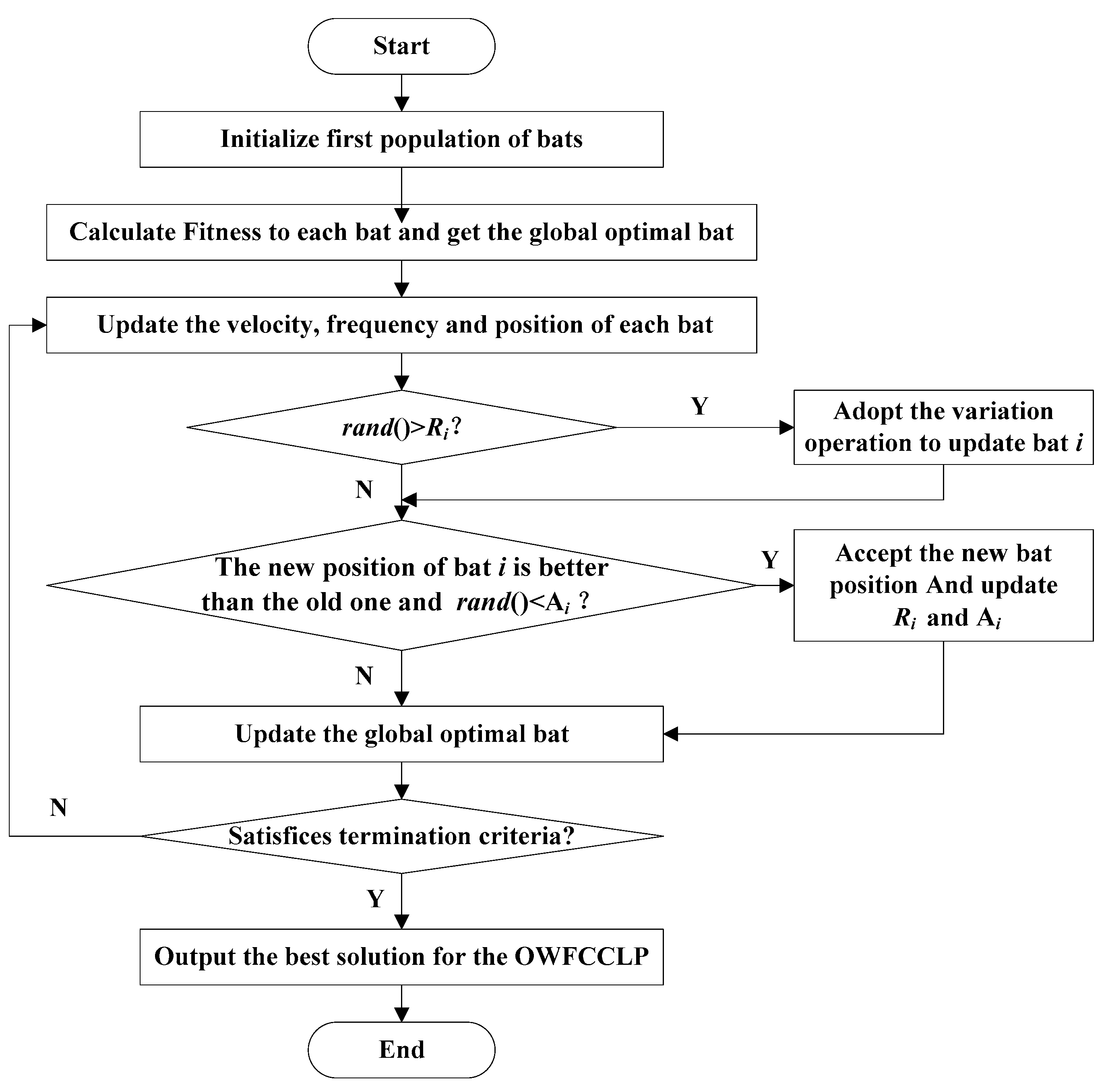

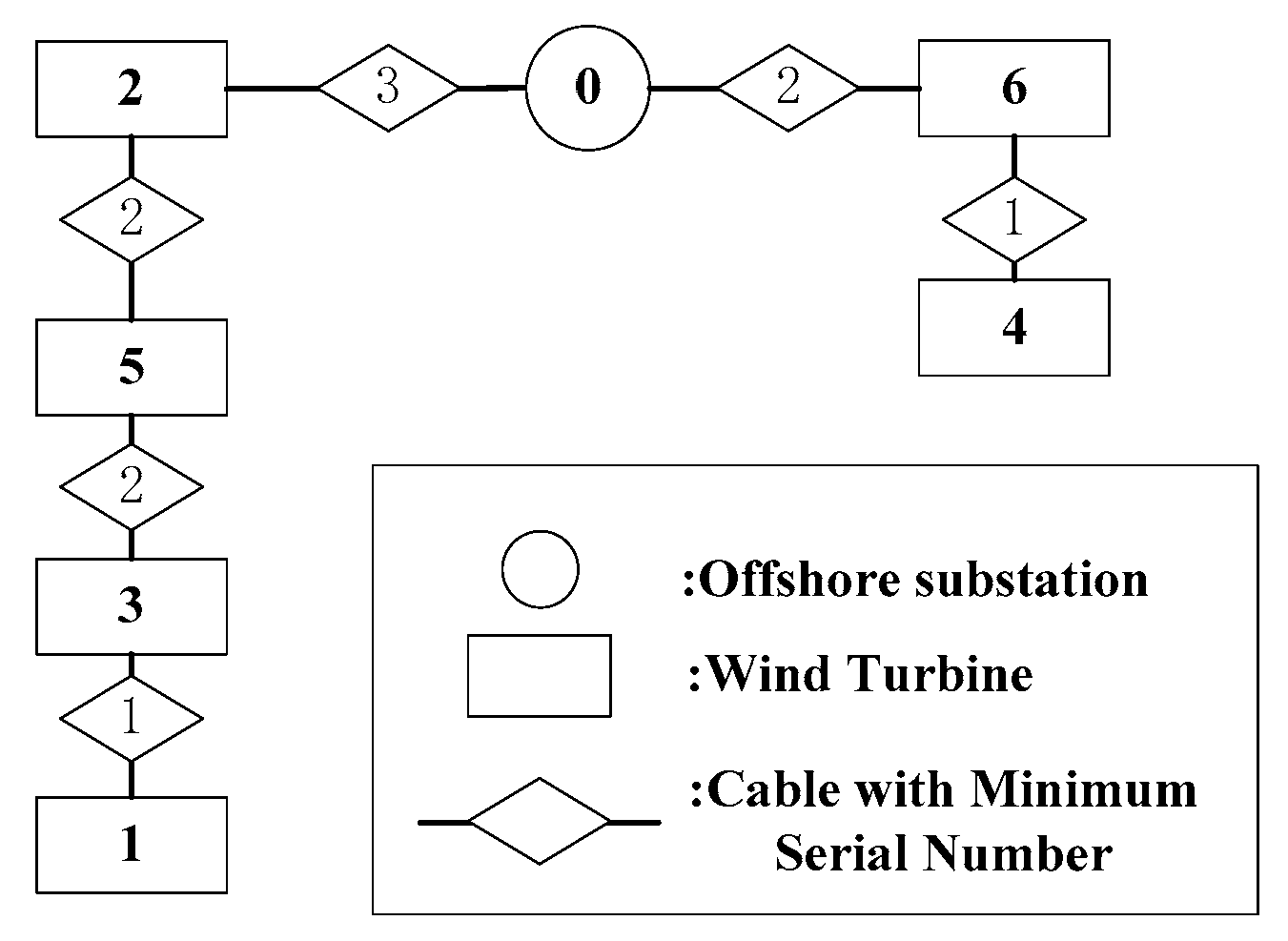

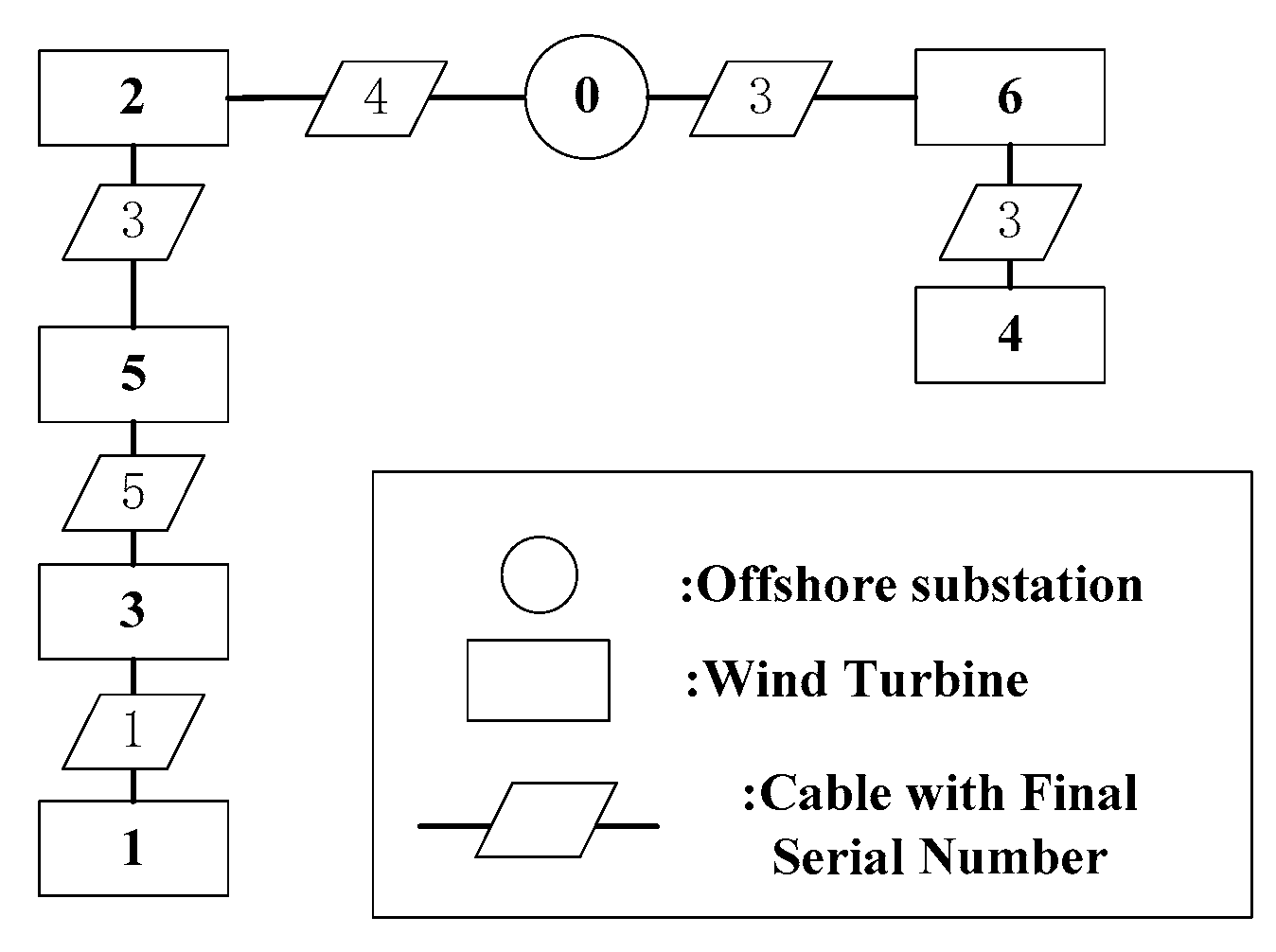
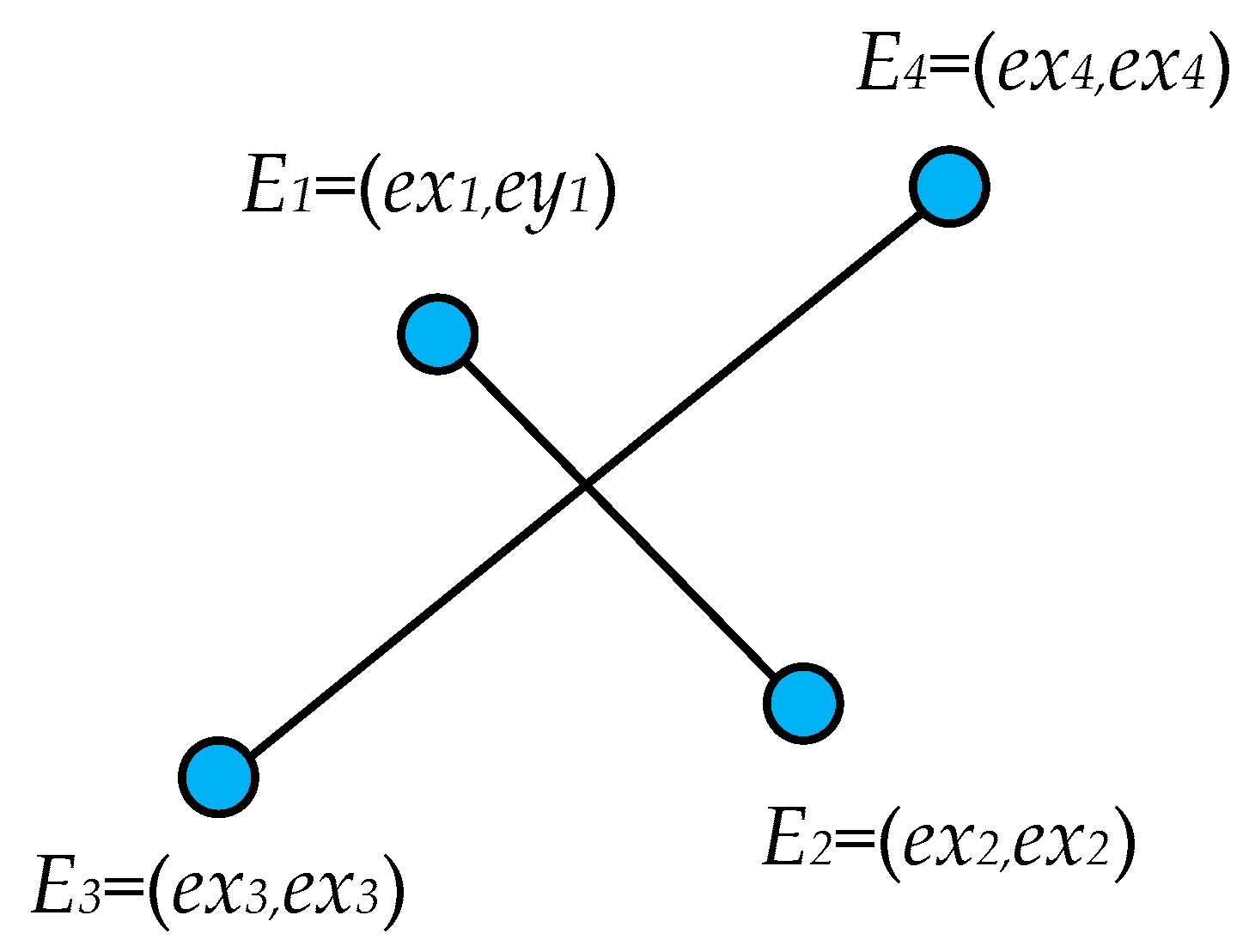
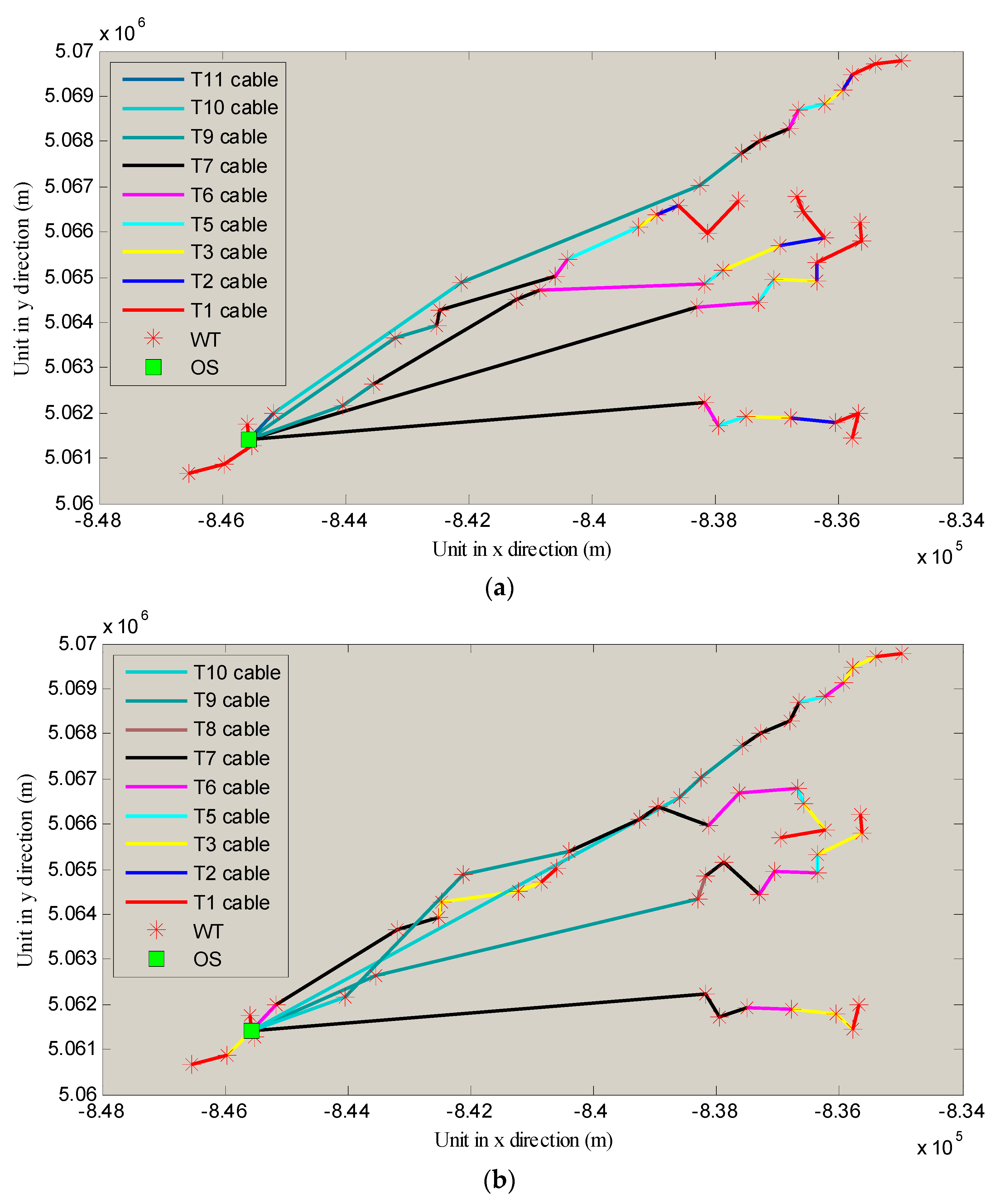
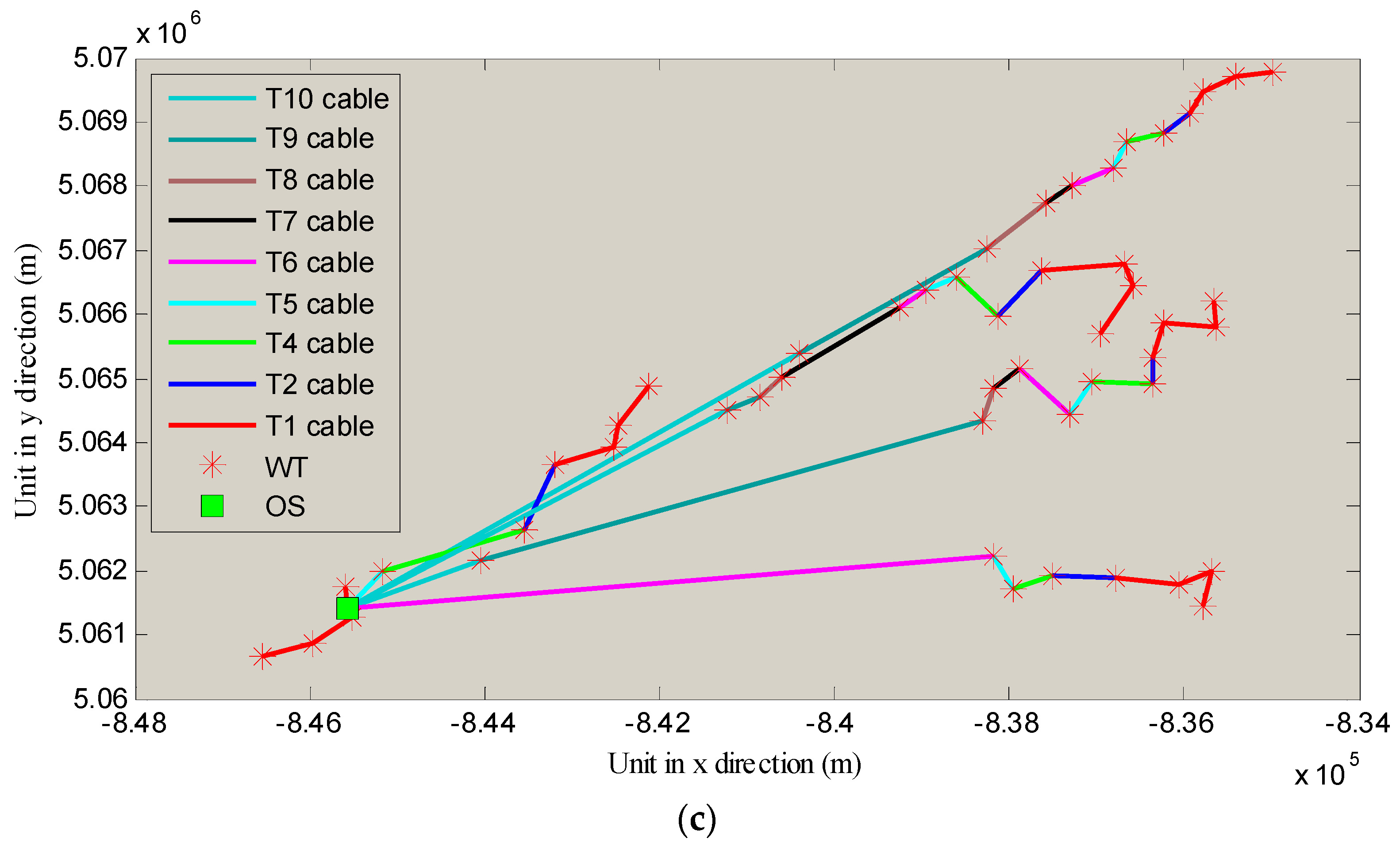
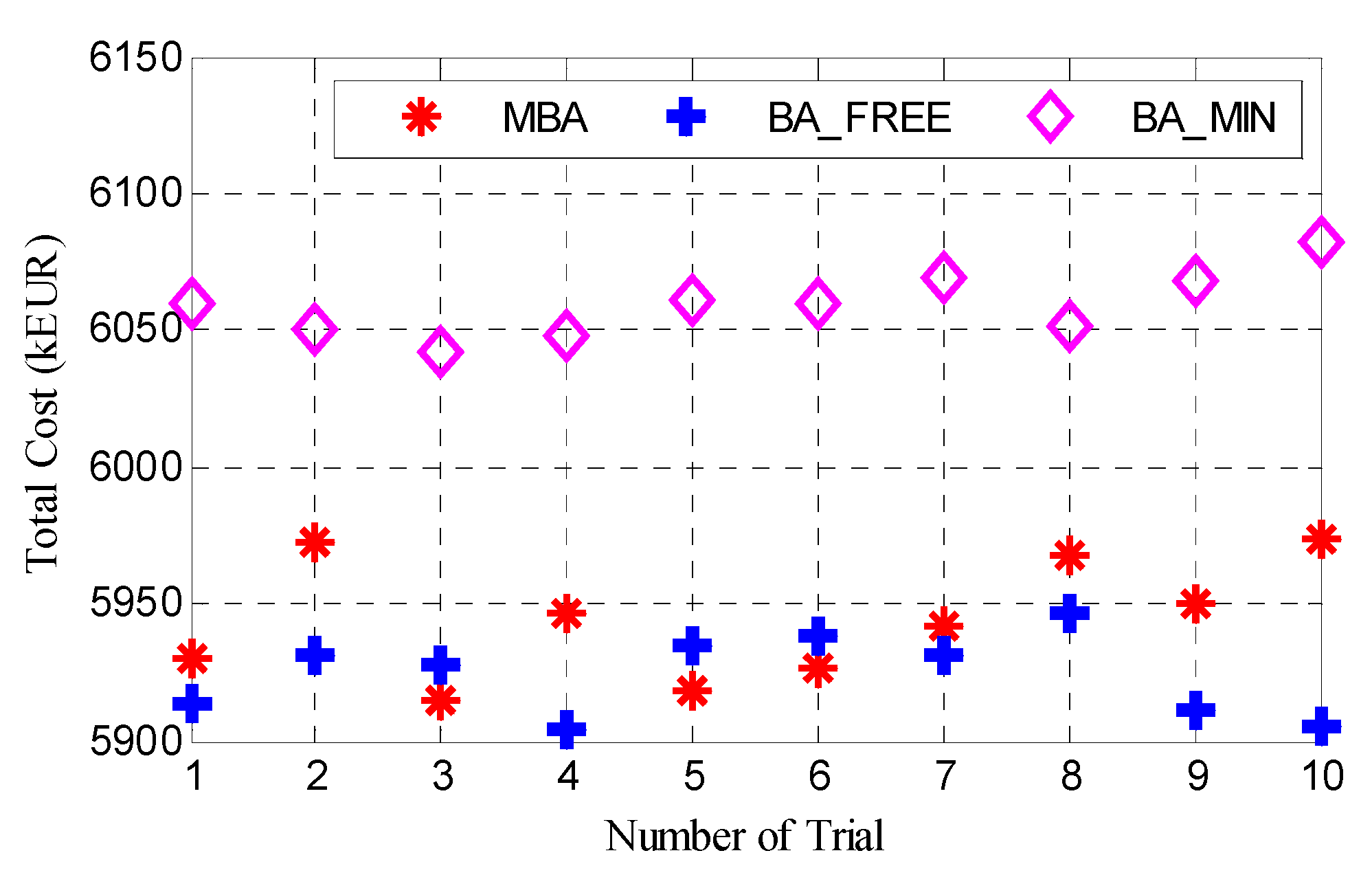
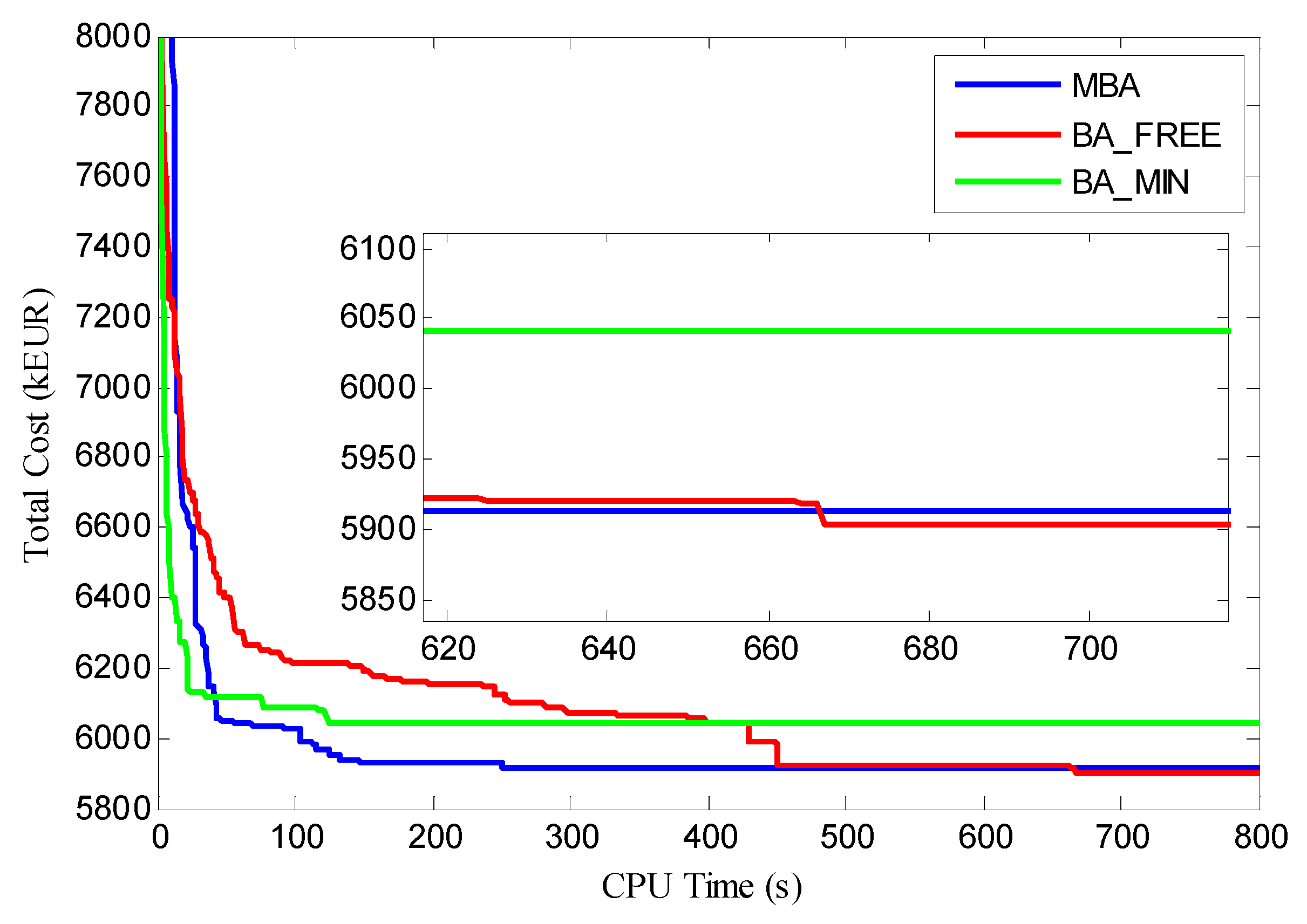
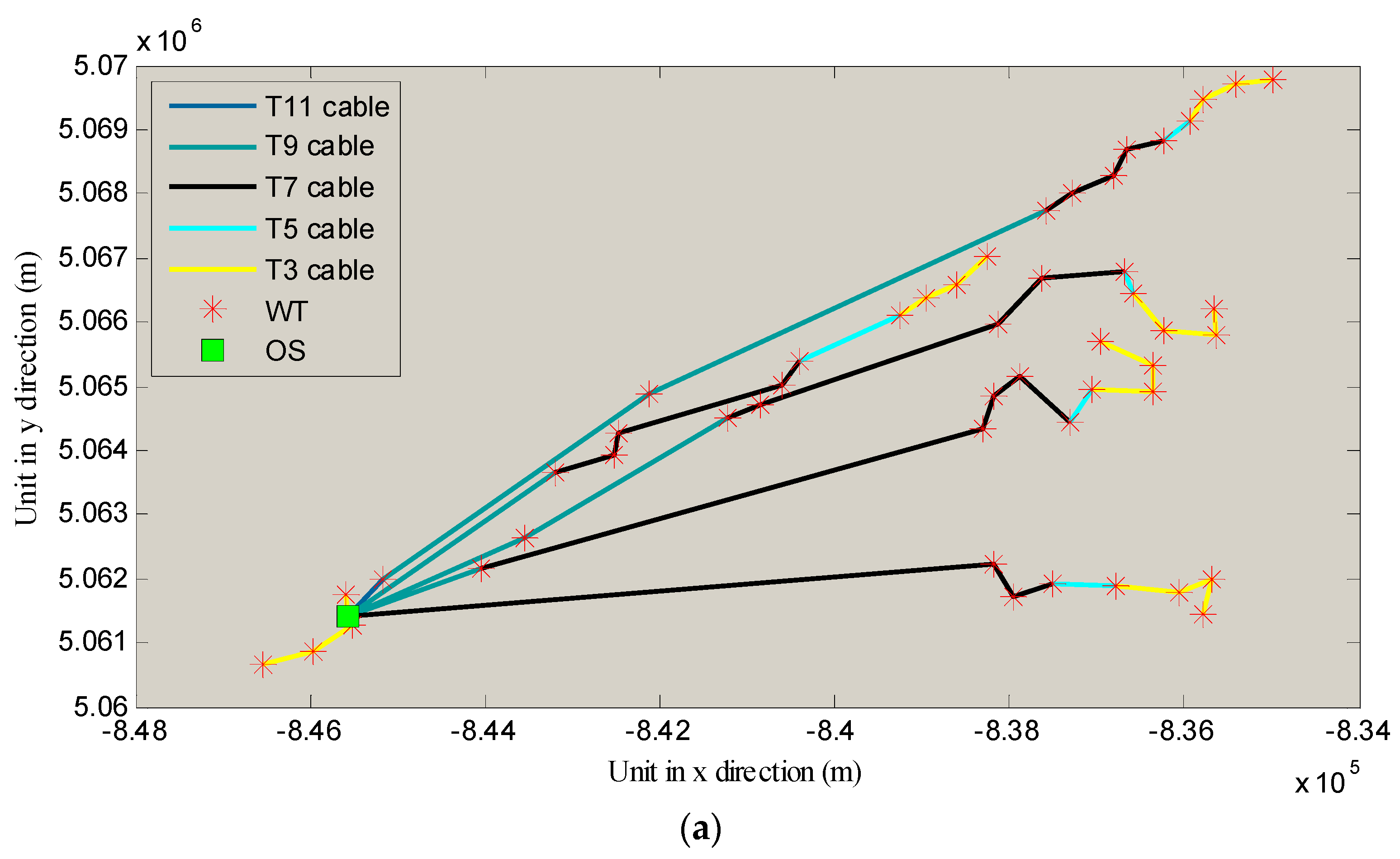
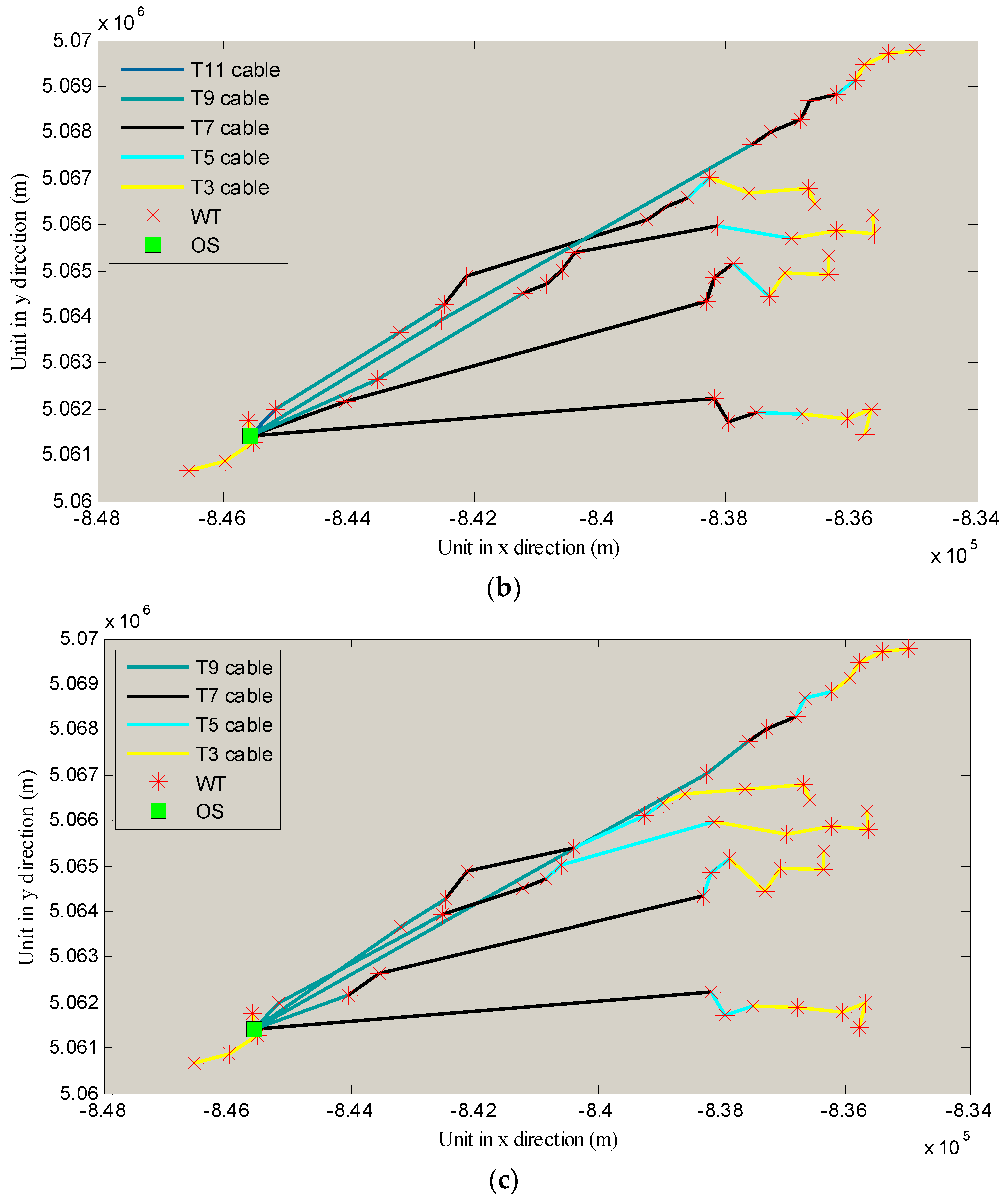
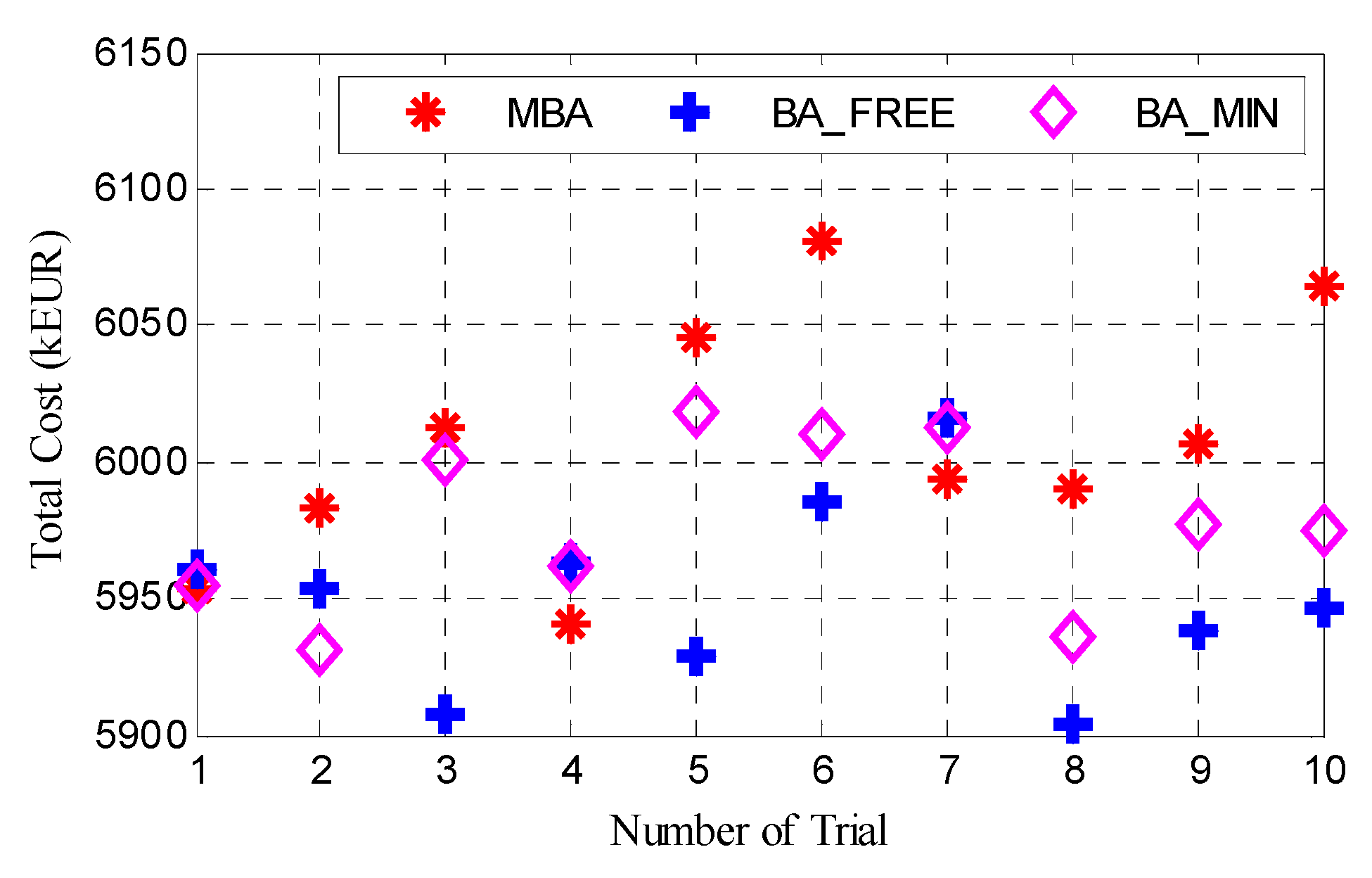
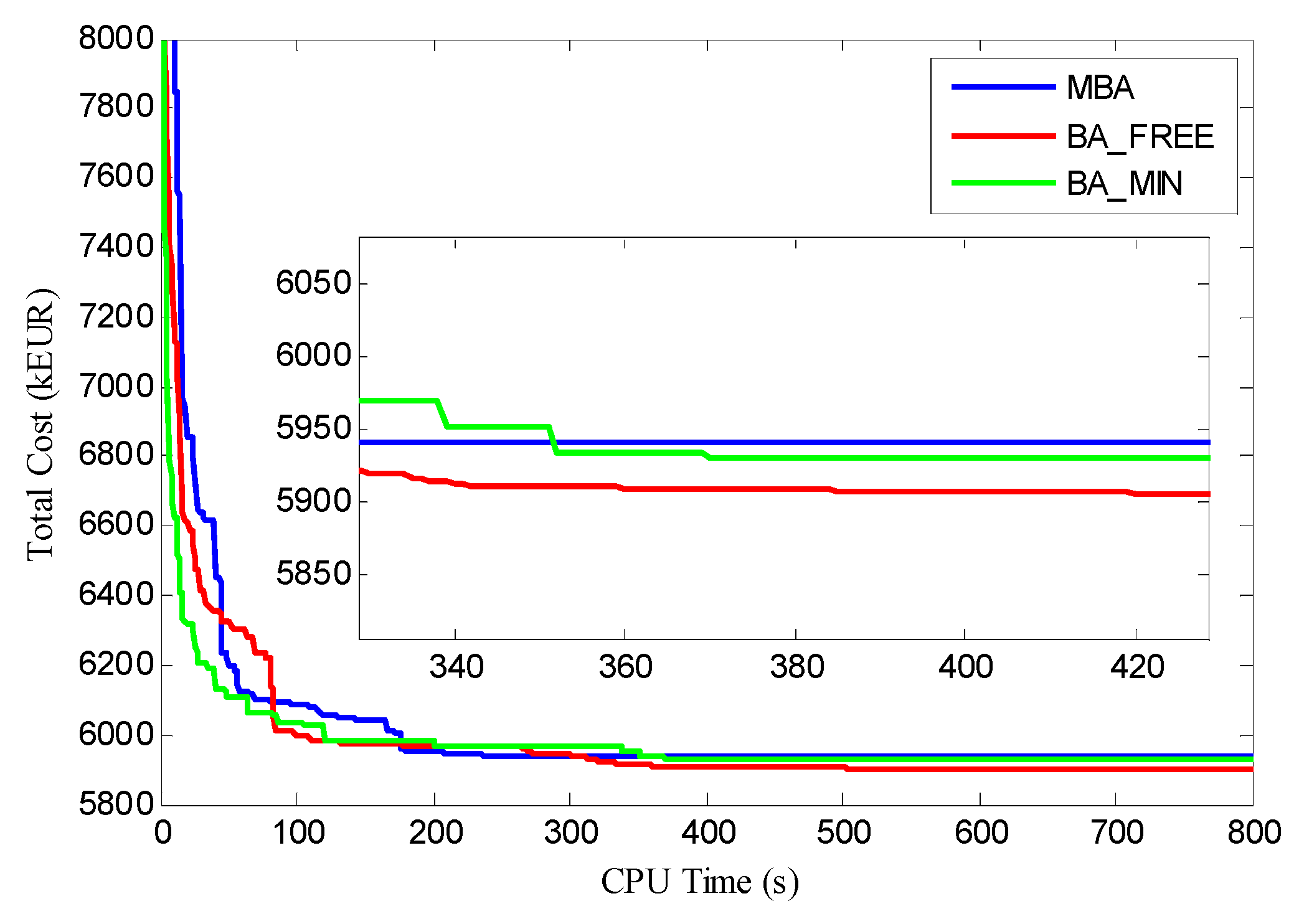
| Description | Units | Scenario I | Scenario II | ||||
|---|---|---|---|---|---|---|---|
| MBA | BA_FREE | BA_MIN | MBA | BA_FREE | BA_MIN | ||
| Trenching cost of cables | [kEUR] | 1126.94 | 1091.77 | 1063.08 | 1128.29 | 1136.05 | 1130.98 |
| Purchase cost of cables | [kEUR] | 2625.46 | 2883.08 | 2645.9 | 2803.31 | 2790.14 | 2664.48 |
| PLC | [kEUR] | 2161.84 | 1928.86 | 2333.12 | 2009.57 | 1977.65 | 2136.07 |
| Total cost | [kEUR] | 5914.24 | 5903.72 | 6042.09 | 5941.17 | 5903.84 | 5931.53 |
© 2019 by the authors. Licensee MDPI, Basel, Switzerland. This article is an open access article distributed under the terms and conditions of the Creative Commons Attribution (CC BY) license (http://creativecommons.org/licenses/by/4.0/).
Share and Cite
Qi, Y.; Hou, P.; Yang, L.; Yang, G. Simultaneous Optimisation of Cable Connection Schemes and Capacity for Offshore Wind Farms via a Modified Bat Algorithm. Appl. Sci. 2019, 9, 265. https://doi.org/10.3390/app9020265
Qi Y, Hou P, Yang L, Yang G. Simultaneous Optimisation of Cable Connection Schemes and Capacity for Offshore Wind Farms via a Modified Bat Algorithm. Applied Sciences. 2019; 9(2):265. https://doi.org/10.3390/app9020265
Chicago/Turabian StyleQi, Yuanhang, Peng Hou, Liang Yang, and Guangya Yang. 2019. "Simultaneous Optimisation of Cable Connection Schemes and Capacity for Offshore Wind Farms via a Modified Bat Algorithm" Applied Sciences 9, no. 2: 265. https://doi.org/10.3390/app9020265
APA StyleQi, Y., Hou, P., Yang, L., & Yang, G. (2019). Simultaneous Optimisation of Cable Connection Schemes and Capacity for Offshore Wind Farms via a Modified Bat Algorithm. Applied Sciences, 9(2), 265. https://doi.org/10.3390/app9020265





